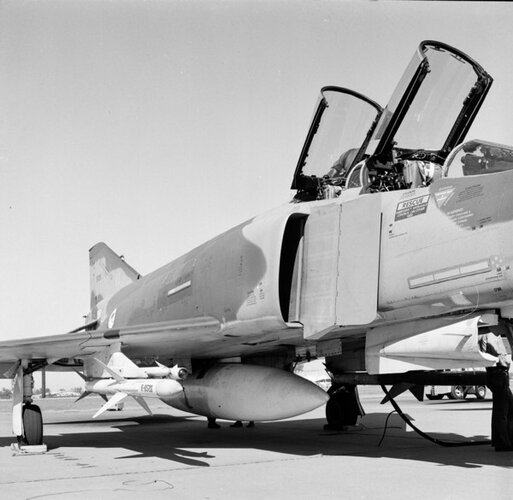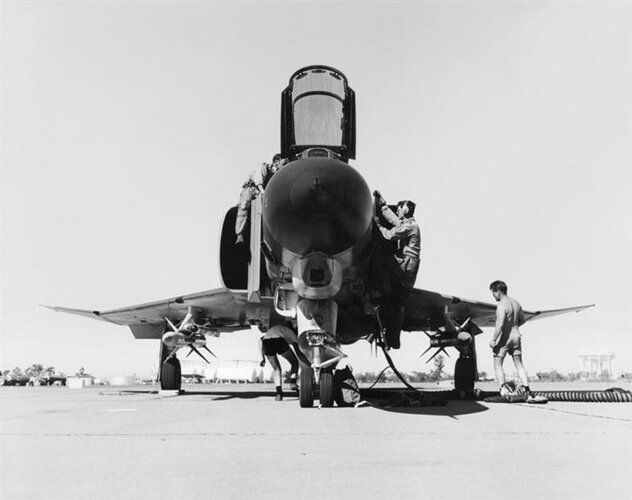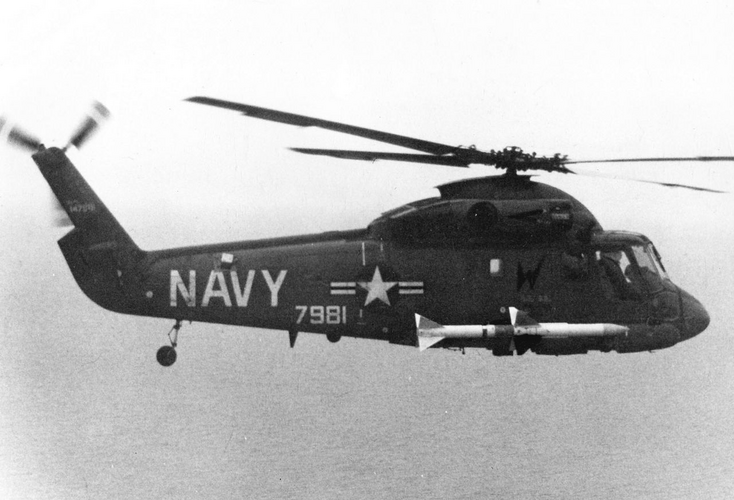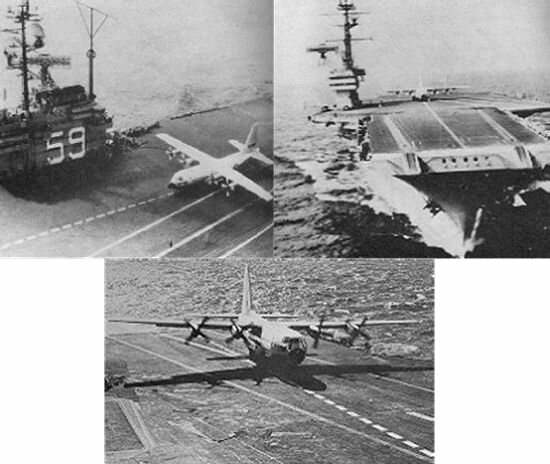Plus you'd need another aircraft to illuminate the targetYou better have a very skinny pilot and you won't be in the air for long...
You are using an out of date browser. It may not display this or other websites correctly.
You should upgrade or use an alternative browser.
You should upgrade or use an alternative browser.
AIM-7 Sparrow
- Thread starter AN/AWW-14(V)
- Start date
T. A. Gardner
ACCESS: Top Secret
- Joined
- 18 February 2021
- Messages
- 1,116
- Reaction score
- 1,979
Given something like 200 or 300 lbs. for fuel and a pilot a ground based radar should suffice...Plus you'd need another aircraft to illuminate the targetYou better have a very skinny pilot and you won't be in the air for long....
- Joined
- 18 May 2019
- Messages
- 640
- Reaction score
- 1,671
F-2
ACCESS: Top Secret
- Joined
- 22 May 2020
- Messages
- 865
- Reaction score
- 1,664
It’s mentioned the Aim-7g would have been on the F-111. Was it more similar to the E or F? How would it differ?
The Aim-7n was supposedly produced in very small numbers for the F-15. All I found was it was an upgraded aim-7n. Anyone know about this one? What type of seaker?
The Aim-7n was supposedly produced in very small numbers for the F-15. All I found was it was an upgraded aim-7n. Anyone know about this one? What type of seaker?
- Joined
- 27 December 2005
- Messages
- 17,666
- Reaction score
- 25,728
From memory it was AIM-7E-2 with a new seeker adapted to the F-111D radar.It’s mentioned the Aim-7g would have been on the F-111. Was it more similar to the E or F? How would it differ?
Did the AIM-7G reach prototype stage before being cancelled?From memory it was AIM-7E-2 with a new seeker adapted to the F-111D radar.It’s mentioned the Aim-7g would have been on the F-111. Was it more similar to the E or F? How would it differ?
- Joined
- 27 December 2005
- Messages
- 17,666
- Reaction score
- 25,728
I've read that it did.Did the AIM-7G reach prototype stage before being cancelled?From memory it was AIM-7E-2 with a new seeker adapted to the F-111D radar.It’s mentioned the Aim-7g would have been on the F-111. Was it more similar to the E or F? How would it differ?
- Joined
- 27 December 2005
- Messages
- 17,666
- Reaction score
- 25,728
SPARROW MISSILE
Senator CANNON. General, the Air Force was funding SPARROW G missile development with F-111 funds. I would like to ask you if you think that is proper first, and then ask you why you are request ing $ 800,000 for a SPARROW G missile in the F-111 aircraft program for fiscal year 1971 , when this appears to be a cancelled program.
General FERGUSON. May I ask General Glasser to respond to that if he has the data . I don't have that in front of me.
General GLASSER. The only money that we have had in the SPARROW G that I am aware of to date has been R. & D. money, in augmentation of the Navy's R. & D. and related to the F - 111. To date, development has continued ; however, the procurement program has been deferred.
Senator CANNON. As I understand it, there is $800,000 for SPARROW G missiles in the 1971 program . Now I may be in error on that.
General Pitts. That is being researched in the staff right now, Senator Cannon, and there is a proposed answer on its way back over for the record of your subcommittee.
( The information follows
The rationale behind funding this missile under the F-111 R&D program is based on the fact that the task to be funded was essentially that of making the F-111D aircraft capable of carrying the Navy -developed Sparrow AIM-7F missile. ( The F - 111D avionics system utilizes radar frequencies which are incompatible with the AIM-7F . The AIM-7G missile is the AIM - 7F with a new , F-111D -compatible radar seeker. ) No new missile was developed. An existing missile was changed to permit carriage and use on the F-111D aircraft. The major R&D costs and tasks were related to aircraft needs, i.e. , the missile control set contained in the aircraft. Since the contractor ( Raytheon ) was responsible for the combined missile / aircraft interface effort, and since the problem was essentially to place a 90 % in -being missile on an aircraft still in development, it was logical to fund the entire interface effort under the aircraft line item.
There was an item in the FY 71 F-111 R & D program element for $ 500,000 for the AIM-7G missile. This was in support of the development program de scribed above to fund for completion of the Category II test phase. There was a staff estimate that an additional $ 300,000 for a total of $ 800,000 would be required , however, it was not in the budget. Regarding the procurement program there are no FY 71 monies in the F -111 program element for production of the AIM-7G . All previous procurement fund requests were deferred pending the out come of the development effort.
As a result of a recent review by the Air Force of the AIM-7G R&D program, this effort was cancelled and a stop work notice issued on 19 March 1970. This decision was based on the reduced number of F-111D aircraft, the high procurement cost, potential follow-on cost savings, and severe budgetary restrictions.
Funds are, therefore, no longer required for the AIM-7G. The funds will be required, however, for other F- 111 development work such as the Titanium wing carry -through box and should not be deleted.
- Joined
- 27 December 2005
- Messages
- 17,666
- Reaction score
- 25,728
Its interesting thar it is described as an AIM-7F variant as AIM-7F didn't enter service until 1976. However AIM-7F development did start in 1966.
- Joined
- 27 December 2005
- Messages
- 17,666
- Reaction score
- 25,728
Our development and development planning actions are directed both toward improvements of existing air launched missiles and toward improving our ca pabilities by initiating new missile developments. Further, this applies both to air- to-air and air - to - surface missile developments. In the air- to -air missile field, we have several developments intended to improve the capability of inventory missiles in the close -in , maneuvering combat situation . The AIM-7F and AIM - 7G are advanced versions of the current AIM 7E SPARROW radar guided missile for use with the F - 4 and F-111, respectively. They are modifications to the current AIM -7E to improve [ deleted ] capability.
pathology_doc
ACCESS: Top Secret
- Joined
- 6 June 2008
- Messages
- 1,585
- Reaction score
- 1,503
Aviation enthusiast though I am, it took me a LONG time to learn that just because the pylon can take the weight of a store doesn't mean you can use it.Technically the Sparrows can hang on the pylon but there is no wiring or capability for them to be functional.
kaiserd
I really should change my personal text
- Joined
- 25 October 2013
- Messages
- 1,665
- Reaction score
- 1,718
Plans for arming USAF F-111s with Sparrows as late as the early 70’s?
A late vestige of the “fighter” part of the “fighter-bomber” role that in practice the F-111 abandoned to the F-4 (and later types) or something more role-specific that may have reflected in the fine tuning/ tailoring of the Sparrow variant (possible intended use in the NORAD anti-bomber role?).
Appreciate may be at least as much a F-111 as a Sparrow related question.
A late vestige of the “fighter” part of the “fighter-bomber” role that in practice the F-111 abandoned to the F-4 (and later types) or something more role-specific that may have reflected in the fine tuning/ tailoring of the Sparrow variant (possible intended use in the NORAD anti-bomber role?).
Appreciate may be at least as much a F-111 as a Sparrow related question.
Do any of the company display models or artwork of F.111 show Sparrow carriage ?
- Joined
- 27 December 2005
- Messages
- 17,666
- Reaction score
- 25,728
F-111D radar was supposed to be air/air capable unlike other F-111 radars. Not sure if the Sparrow was intended for self-defence purposes or was a relic of F-111 being a general purpose fighter but it was dropped once the F-15 got underway.Plans for arming USAF F-111s with Sparrows as late as the early 70’s?
A late vestige of the “fighter” part of the “fighter-bomber” role that in practice the F-111 abandoned to the F-4 (and later types) or something more role-specific that may have reflected in the fine tuning/ tailoring of the Sparrow variant (possible intended use in the NORAD anti-bomber role?).
Appreciate may be at least as much a F-111 as a Sparrow related question.
- Joined
- 27 December 2005
- Messages
- 17,666
- Reaction score
- 25,728
Peter E. Davies & Anthony Thornborough F-111 Aardvark (Crowood)Originally,
it was intended that the APQ-130 provide continuous wave target 'illumination' to guide Semi-Active Radar-Homing Ku-Band Raytheon AIM-7G-1 Sparrow III missiles onto such 'painted' targets at launch ranges of up to 60 miles (97km). To set up the aircraft for an optimum missile attack the crew would have flown so that the steering circle was kept inside the allowable steering error circle, thereby keeping the aircraft within missile launch parameters (just as in a Phantom). Although the XAIM-7G never progressed beyond the prototype stage and was cancelled in 1971 just prior to the aircraft entering service, the F-111D's air-to-air capability nevertheless remained far more useful than a mere glorified aerial rendezvous system, proving to be especially useful as an aid to SA. Wizzos could keep a look out for 'bogeys', interrogate their IFF (Identification Friend or Foe transponders) and gain a better overall impression of the threat situation. Brad Insley recalled that
'There was a box to dial-in a transponder code and that tied into the radar highlighting any aircraft "squawking" that code. It was very helpful finding the right tanker. It allowed more precise tracking of a target.'
High-timer and FWIC graduate Dick Brown recalled:
It used to work great. At first the A/A facility was not used much. As tactics improved through the life of the F-111 its use became more and more frequent (and I feel I brought about this change in tactics using the A/A at low-level and at cruise altitudes). When I retired in 1990 we were using it constantly even during day low-Ievel ingress and egress. In fact, A/A in the 'I.)' model was used almost continually during day low-level if there were intercept threats like in Red Flag or local exercises. The possibility of rerigging the F-111Ds with Hughes Raytheon AIM-120 AMRAAM missiles was explored to make use of this capability, but rejected on the grounds that nobody wanted the Aardvark community loitering in racetrack patterns setting up BVR (Beyond Visual Range) 'kill boxes' when they were in high demand for dropping iron and CB''s at speed. BVR MiG-killing was the business of the F-15s, with the F-16s closing-in to mop-up enemy stragglers.
Last edited:
- Joined
- 27 December 2005
- Messages
- 17,666
- Reaction score
- 25,728
Additional Requirements 26 May 1967
Another USAF SMD gave the Mark Il- equipped F-111D the radar -controlled AIM-7G-1 (Sparrow ) air- to - air missile. This would be over and above an improved, infrared, heat -seeking, air -to - air missile, similar to that of the F-111A ( and , as it turned out, the F - 111E ). The request for adaptation of the new ( and later cancelled) Raytheon-developed YAIM -7G Sparrow to the Mark II's fire- control radar came after the 23 June 1966 Mark II contract award to Autonetics, a division of the North American Rockwell Corporation.
- Joined
- 27 December 2005
- Messages
- 17,666
- Reaction score
- 25,728
AIM-7G program was canceled Mar. 19 , 1970.
- Joined
- 21 May 2006
- Messages
- 2,978
- Reaction score
- 2,222
Sorry to divert from the primary subject of the Sparrow missile itself, but can anyone tell me if this Aim-7/Aim-9 pylon arrangement was a standard arrangement? If so does anyone know its official designation please.
Apparently its fitted to a RAAF McDonnell Douglas F-4E Phantom II (A69-7211) was tasked to 'cold soak' Sidewinder and Sparrow missiles in the troposphere at 53,000 feet above Darwin in a joint exercise for the RAAF and the United States Navy in 1972.
Regards
Pioneer
Apparently its fitted to a RAAF McDonnell Douglas F-4E Phantom II (A69-7211) was tasked to 'cold soak' Sidewinder and Sparrow missiles in the troposphere at 53,000 feet above Darwin in a joint exercise for the RAAF and the United States Navy in 1972.
Regards
Pioneer
Attachments
- Joined
- 16 April 2008
- Messages
- 9,545
- Reaction score
- 14,291
Sorry to divert from the primary subject of the Sparrow missile itself, but can anyone tell me if this Aim-7/Aim-9 pylon arrangement was a standard arrangement? If so does anyone know its official designation please.
Apparently its fitted to a RAAF McDonnell Douglas F-4E Phantom II (A69-7211) was tasked to 'cold soak' Sidewinder and Sparrow missiles in the troposphere at 53,000 feet above Darwin in a joint exercise for the RAAF and the United States Navy in 1972.
Regards
Pioneer
The pylon is the standard USN LAU-17/A, which was meant to carry Sparrow. (Note the straight leading edge compared to the curved on in the USAF equivalent MAU-12 pylon.). But this combo of Sparrow and Sidewinder is not a standard configuration at all.
When Sparrow was not carried, it could have side rails added for Sidewinder. But the two together look to me like they would interfere with each other. I think that the Sparrow on the starboard pylon (left in the photos) may be missing a forward fin to allow the two missiles to fit together.
Cold Soak to me implies this was an instrumented test, not necessarily a live fire exercise, though the Sparrow on the port pylon doesn't have a Sidewinder to deal with and might be live.
My source for info on the pylons and configurations is here: https://phantomphacts.blogspot.com/2018/10/the-f-4-inboard-pylons.html?m=1
Last edited:
- Joined
- 16 April 2008
- Messages
- 9,545
- Reaction score
- 14,291
A bit off-topic however could a LAU-17/A be mounted on an USAF Phantom and a MAU-12 pylon on an USN Phantom?
Evidently, since here we see a LAU-17 on an F-4E, which the USN never flew. But it might have been just for this trial -- I can't find any other pics of an F-4E with that LAU-17 pylon. Whether the wiring in the wing was 100% compatible is a different question -- I can well imagine that USAF aircraft weren't wired for Sparrow to the wing stations, since it was never a standard loadout. (The days before standard data buses...)
I did find one more pic likely from the same trial:
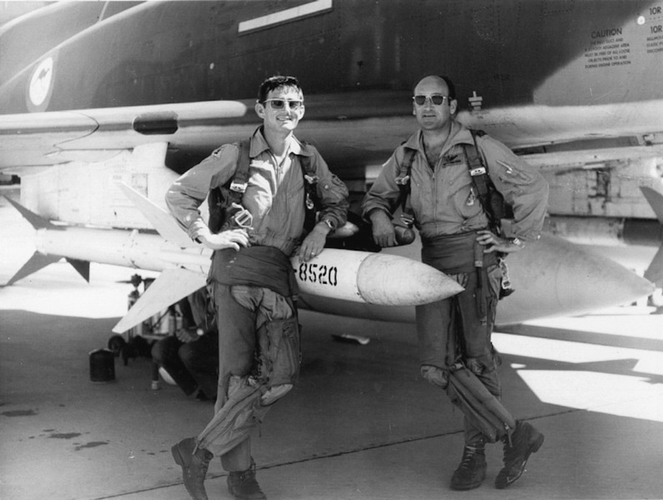
- Joined
- 21 May 2006
- Messages
- 2,978
- Reaction score
- 2,222
Thank you TomS for your time and effort - very interesting.Sorry to divert from the primary subject of the Sparrow missile itself, but can anyone tell me if this Aim-7/Aim-9 pylon arrangement was a standard arrangement? If so does anyone know its official designation please.
Apparently its fitted to a RAAF McDonnell Douglas F-4E Phantom II (A69-7211) was tasked to 'cold soak' Sidewinder and Sparrow missiles in the troposphere at 53,000 feet above Darwin in a joint exercise for the RAAF and the United States Navy in 1972.
Regards
Pioneer
The pylon is the standard USN LAU-17/A, which was meant to carry Sparrow. (Note the straight leading edge compared to the curved on in the USAF equivalent MAU-12 pylon.). But this combo of Sparrow and Sidewinder is not a standard configuration at all.
When Sparrow was not carried, it could have side rails added for Sidewinder. But the two together look to me like they would interfere with each other. I think that the Sparrow on the starboard pylon (left in the photos) may be missing a forward fin to allow the two missiles to fit together.
Cold Soak to me implies this was an instrumented test, not necessarily a live fire exercise, though the Sparrow on the port pylon doesn't have a Sidewinder to deal with and might be live.
My source for info on the pylons and configurations is here: https://phantomphacts.blogspot.com/2018/10/the-f-4-inboard-pylons.html?m=1
Regards
Pioneer
I don't recall the details but didn't NASA back in the 60s look at making two-stage sounding rockets from surplus 1.8KS7800 rocket-motors and tail-fins from retired AIM-7As and AIM-7Cs? I think NASA may've got as far as prototypes being launched.
On another note how much technical documentation is available publicly on the AIM-7D's rocket-motor which was a prepackaged liquid bipropellant rocket-motor? I do know it was from the same family as the rocket-motor used in the AGM-12 Bulldog ASM.
- Joined
- 23 August 2011
- Messages
- 1,580
- Reaction score
- 4,689
The UK was looking to add Amraam to Nimrod MRA.4 as well...That talk about the AIM-7G for F-111 reminds me of the A-12 Avenger II having AMRAAM capability for self defense and also for fleet defense secondary role.
Wonder what the weirdest installation woul have been for Sparrow, Sky Flash, Aspide or Amraam..?
Firefinder
ACCESS: Top Secret
- Joined
- 5 October 2019
- Messages
- 1,036
- Reaction score
- 1,863
The Navy had an idea to have the C130 carry Aim54 Pheonixs.The UK was looking to add Amraam to Nimrod MRA.4 as well...That talk about the AIM-7G for F-111 reminds me of the A-12 Avenger II having AMRAAM capability for self defense and also for fleet defense secondary role.
Wonder what the weirdest installation woul have been for Sparrow, Sky Flash, Aspide or Amraam..?
T. A. Gardner
ACCESS: Top Secret
- Joined
- 18 February 2021
- Messages
- 1,116
- Reaction score
- 1,979
Would the C-130 be carrier capable?The Navy had an idea to have the C130 carry Aim54 Pheonixs.The UK was looking to add Amraam to Nimrod MRA.4 as well...That talk about the AIM-7G for F-111 reminds me of the A-12 Avenger II having AMRAAM capability for self defense and also for fleet defense secondary role.
Wonder what the weirdest installation woul have been for Sparrow, Sky Flash, Aspide or Amraam..?
T. A. Gardner
ACCESS: Top Secret
- Joined
- 18 February 2021
- Messages
- 1,116
- Reaction score
- 1,979
The interesting part is that the pilots made repeated landings and take offs at higher and higher loads on the plane at weights between 85,000 and 121,000 lbs. A total of 29 touch and go landings were done and 21 full stop landings and subsequent take offs were performed. The C-130 did not have arresting gear and made unassisted landings. The take offs were not catapult assisted.I'd love to see that repeated with a C-130J landing on a Nimitz or Ford class CVN.
This remains to date, the heaviest and largest aircraft to ever land and take off from a carrier.
F-2
ACCESS: Top Secret
- Joined
- 22 May 2020
- Messages
- 865
- Reaction score
- 1,664
The designation AIM-7N was allocated to an upgraded version of the AIM-7F for use with the USAF's F-15 MSIP (Multistage Improvement Program). This version was not produced in quantity.
Anyone know what the story of Aim-7N was and what it entailed?
pathology_doc
ACCESS: Top Secret
- Joined
- 6 June 2008
- Messages
- 1,585
- Reaction score
- 1,503
I'm going to make a wild guess and see if I'm proved right. The later marks of Skyhawk and Phantom II, rising into letters as high as S, were allocated to early versions that were essentially rebuilt to bring them up to date. A similar thing was done with early Sidewinders. I'm going to suppose that AIM-7N might have been intended as such an upgrade of F, but that it was found easier and more economical to build -7M missiles from scratch and to dispose of the F's in live-fire exercises, expend existing stocks in battle (the various Gulf wars and no-fly zones) or whatever else they do to run an obsolete mark down.The designation AIM-7N was allocated to an upgraded version of the AIM-7F for use with the USAF's F-15 MSIP (Multistage Improvement Program). This version was not produced in quantity.
Anyone know what the story of Aim-7N was and what it entailed?
F-2
ACCESS: Top Secret
- Joined
- 22 May 2020
- Messages
- 865
- Reaction score
- 1,664
That’s my theory but one snag is it was mentioned to me by a F-16 ADF pilot, a large number of Aim-7f where rebuilt with a M seeker.I'm going to make a wild guess and see if I'm proved right. The later marks of Skyhawk and Phantom II, rising into letters as high as S, were allocated to early versions that were essentially rebuilt to bring them up to date. A similar thing was done with early Sidewinders. I'm going to suppose that AIM-7N might have been intended as such an upgrade of F, but that it was found easier and more economical to build -7M missiles from scratch and to dispose of the F's in live-fire exercises, expend existing stocks in battle (the various Gulf wars and no-fly zones) or whatever else they do to run an obsolete mark down.The designation AIM-7N was allocated to an upgraded version of the AIM-7F for use with the USAF's F-15 MSIP (Multistage Improvement Program). This version was not produced in quantity.
Anyone know what the story of Aim-7N was and what it entailed?
- Joined
- 16 April 2008
- Messages
- 9,545
- Reaction score
- 14,291
To confuse things further, I see a 1984 reference in a Congressional hearing to AIM-7N being requested as a retrofit to USANG F-4Ds (along with AIM-9L and some bombing accuracy updates). Could be a typo for AIM-7M, however.

Department of Defense appropriations for fiscal year 1985
www.google.com
pathology_doc
ACCESS: Top Secret
- Joined
- 6 June 2008
- Messages
- 1,585
- Reaction score
- 1,503
Now you're giving me an idea for an espionage satire (a serious one, not a slapstick comedy) in which months of time and many assets, human and material, are wasted to learn the truth about a new weapon that only existed on paper because someone mistyped something.To confuse things further, I see a 1984 reference in a Congressional hearing to AIM-7N being requested as a retrofit to USANG F-4Ds (along with AIM-9L and some bombing accuracy updates). Could be a typo for AIM-7M, however.

Department of Defense appropriations for fiscal year 1985
www.google.com
- Joined
- 16 April 2008
- Messages
- 9,545
- Reaction score
- 14,291
I'm certain this has happened in real life.Now you're giving me an idea for an espionage satire (a serious one, not a slapstick comedy) in which months of time and many assets, human and material, are wasted to learn the truth about a new weapon that only existed on paper because someone mistyped something.To confuse things further, I see a 1984 reference in a Congressional hearing to AIM-7N being requested as a retrofit to USANG F-4Ds (along with AIM-9L and some bombing accuracy updates). Could be a typo for AIM-7M, however.

Department of Defense appropriations for fiscal year 1985
www.google.com
Similar threads
-
RIM-101 ship-based tube-launched missile
- Started by Vahe Demirjian
- Replies: 1
-
Advanced US short-range AAMS for the 1970s - AIM-82, AIM-95 Agile, CLAW
- Started by overscan (PaulMM)
- Replies: 170
-
Sparrow-X: Nuclear Sparrow
- Started by overscan (PaulMM)
- Replies: 7
-
First generation active radar missiles
- Started by Archibald
- Replies: 40
-

